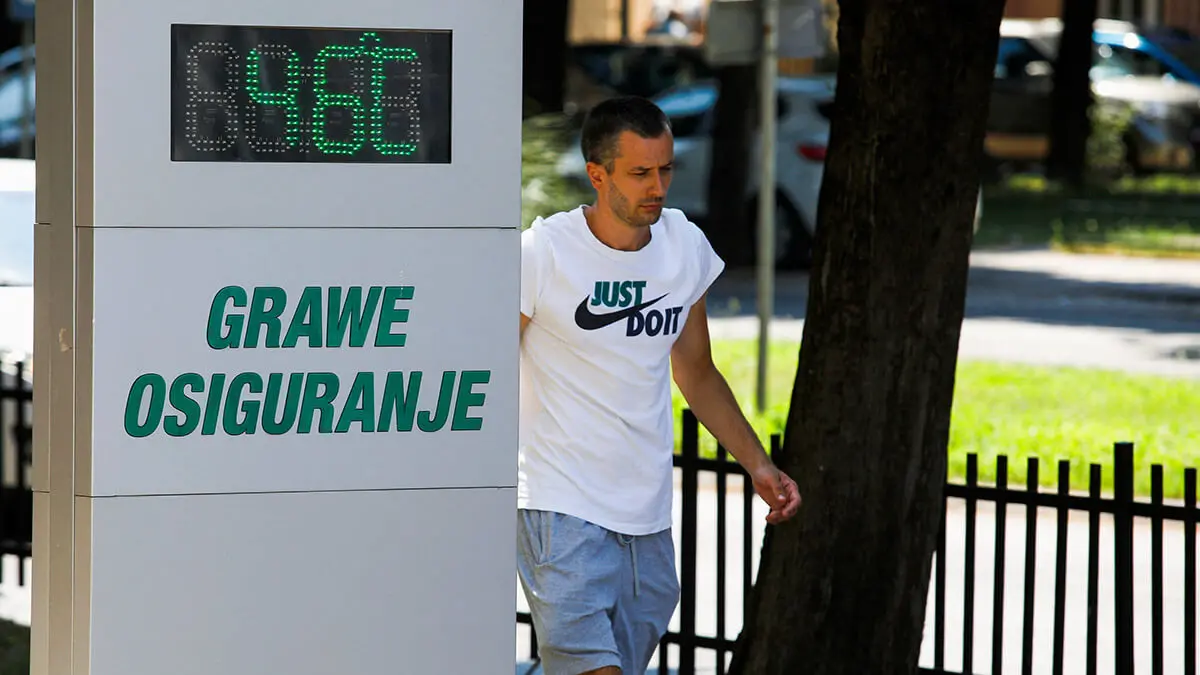Heat kills more in Europe than road accidents

The heat is plaguing Europeans to such an extent that, according to data provided by the Barcelona Institute for Global Health (ISGlobal), 47,690 people died in the EU in 2023 from heat stroke and other effects caused by the intensity of the climate.
This is very significant, especially considering that heat is killing more people than, for example, road accidents: the European Commission reported that 20,400 people died in various road accidents last year.
So, the heat is killing twice as many people and it does not look like this year's intense summer will have a more flattering report. Countries such as Greece and Italy have primarily put tourists on alert, because locals who do not need to go outside at peak sunshine hours are sheltering indoors, but tourists are not.
António Guterres, head of the UN, has been reproaching in his speeches about climate change and stresses that it will be inevitable to cross the threshold of 1.5 degrees Celsius established by the Paris Agreement with the goal of accelerating the decarbonisation of the planet.
Joan Ballester of the European Research Council warns that last year almost ‘half of the days’ exceeded this threshold and it is expected that this limit will be crossed on most days before 2027.
What does this mean? It means that the heat will be more extreme, more intense, longer lasting and that there will be long months of sunshine and few months of winter; with its consequent alteration of the rainfall cycle and impact on drought and desertification.
In short, a threat to human life. During the month of June in Greece, six tourists died as a result of the extreme heatwave; the case of British television presenter Michael Mosley, who was on holiday on the island of Symi and disappeared on a route, was particularly noteworthy. They searched for him for four days using planes, drones and boats.
Also striking was the case of a 67-year-old German tourist who left his hotel for a walk on the island of Crete and after a couple of hours contacted his wife to tell her that he was exhausted and dizzy.
In Italy, the Ministry of Health has just issued a red heat warning for 22 cities as of 15 August. Under the "bollino rosso" alert, the highest level of warning is issued for severe heat exposure and intrinsic risks.
The Lazio region, which includes the capital of Rome, has also put in place an emergency plan to deal with the effects of periods of higher temperatures on the health of the population.
"The emergency services of several hospitals have activated a special protocol that prioritises the admission of patients suffering from health problems caused by the heat. Among these patients, in a country with a large population over 65, the majority are elderly," according to Euronews.
But it is not only tourists who are affected, but also many workers exposed to the outdoors: trade unions in the EU have been demanding better conditions for construction workers.
"Today, health and safety issues and injuries in the workplace have to be put in the current context, because climate change is a reality. If you compare work in the construction sector 30 years ago with today, between June and September, the risks are completely different," said Alessandro Genovesi, general secretary of the Fillea CGIL union in Italy.
In Spain, the construction sector approved an action protocol to deal with the high temperatures and it will be applied indefinitely on construction sites and spaces that cannot remain closed.
The National Confederation of Construction (CNC) has issued a protocol for action in the sector. This protocol establishes different general recommendations, ranging from dietary guidelines, the use of appropriate clothing, taking breaks and adapting work schedules to the hours of least exposure.
Depending on the data and information provided by the State Meteorological Agency (AEMET), three scenarios or alert levels are established: green, yellow and orange-red with a consequent taking of measures.
As a general rule, in work requiring the constant presence of a person in the open air, the rotation of the person or providing them with shade will be considered and frequent breaks in cool places will be facilitated.
At green level, work can be carried out normally and at yellow level, outdoor work should be supervised and special attention should be paid to sensitive workers.
When there is an orange-red alert, solitary work will be prohibited, work indoors or in the shade will be prioritised and water will be supplied more frequently. In addition, working hours will also be reduced or modified by adapting working conditions.
Extreme waves
Indeed, research by the Barcelona Institute for Global Health (ISGlobal) indicates that 2023 was the warmest year on record globally and the second warmest in Europe. And 2024 is on track to surpass it.
The study states that humans, like all living beings, are called upon to adapt to new extreme climatic conditions in order to survive.
The researchers used temperature and mortality records from 823 regions in 35 European countries for the period 2015 to 2019 to fit epidemiological models and estimate heat-related mortality in each European region over the past year's cycle.
In 2022, 60,000 people died from the effect of heat in Europe: "In contrast to the summer of 2022, which was characterised by persistent extreme temperatures in the central part of the season, from mid-July to mid-August no large thermal anomalies were recorded during the same weeks in 2023. However, two episodes of high temperatures in mid-July and late August last year caused 57% of the estimated 27,000 deaths".
Of the 47,690 deaths last year from heat stress and other effects of high temperatures, 47,312 deaths occurred in the hottest period, between 29 May and 1 October last year.
In 2023, the countries with the highest heat-related mortality rates were as follows: Greece with 393 deaths per million inhabitants); Bulgaria with 229 deaths per million inhabitants; followed by Italy with 209 deaths per million inhabitants; then Spain with 175 deaths per million inhabitants; in addition, Cyprus with 167 deaths per million inhabitants and Portugal, with 136 deaths per million.
According to the study, who are the most vulnerable? Primarily women and the elderly: "Specifically, after taking population into account, the heat-related mortality rate was 55% higher in females than in males and 768% higher in people over 80 years of age than in people aged 65-79 years".
An interesting point highlighted by the study is the lack of homogeneous daily mortality records in public and private hospitals and in the death registration network in the EU when it comes to heat casualties. So far, the only reliable source of information is Eurostat, the EU's statistical office.
Based on this data failure, the Barcelona Institute for Global Health believes that the actual number of deaths from extreme heat is much higher. ‘And, in 2023, it could have been around 58,000 deaths in the 35 European countries analysed’.
One of the aims of the study is to assess whether there has been a decrease in heat vulnerability in Europe, a process that is generally understood to be an adaptation to rising temperatures.
To do this, the researchers fitted the same type of model to temperature and mortality data for the periods 2000 to 2004; 2005 to 2009; 2010 to 2014; and, 2015 to 2019. In addition, they fed 2023 temperatures and mortality figures into each of the four models to estimate the number of deaths that would have occurred in each period if temperatures had been as high as last year.
"Using this method, it was estimated that, if the temperatures recorded in 2023 had occurred from 2000 to 2004, the estimated heat-related mortality would have exceeded 85,000 deaths; that is, 80% higher than the result derived from heat vulnerability from 2015 to 2019," according to the analysis.


